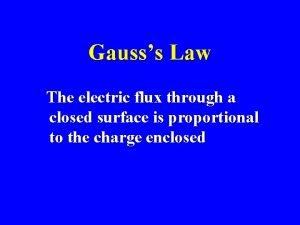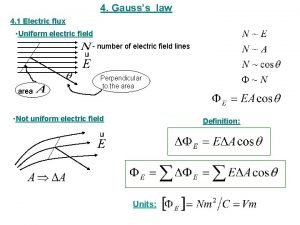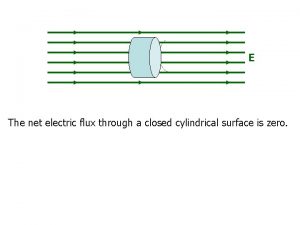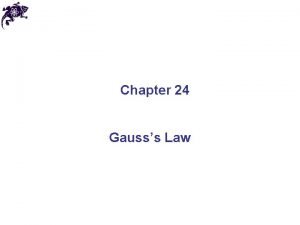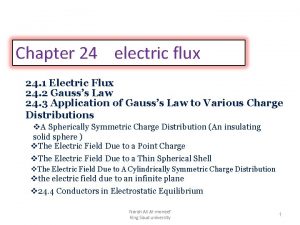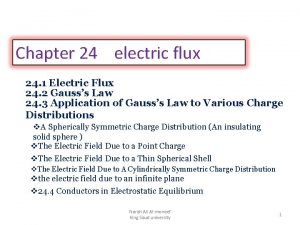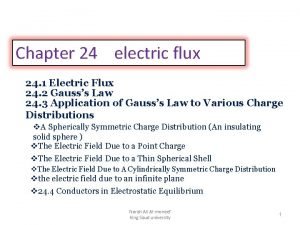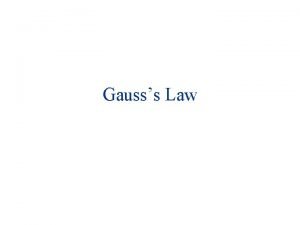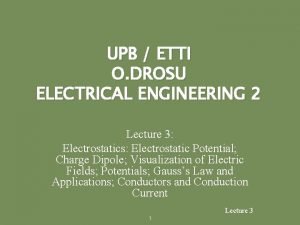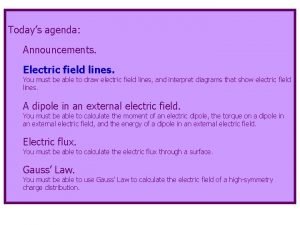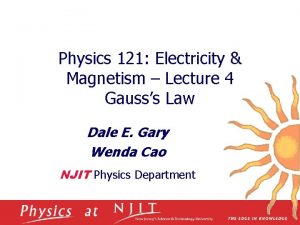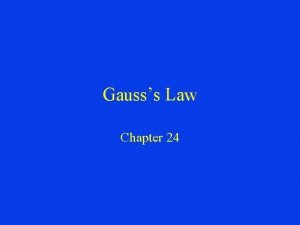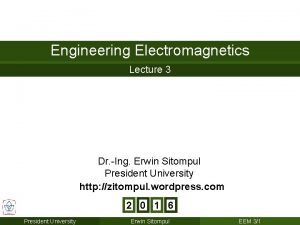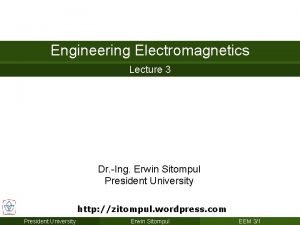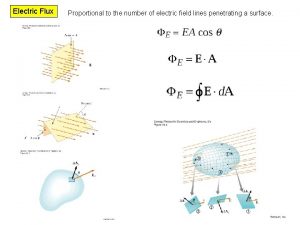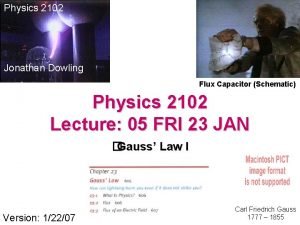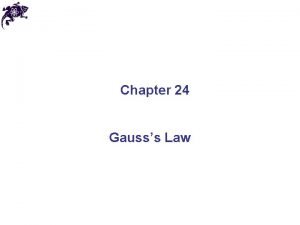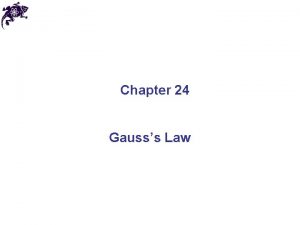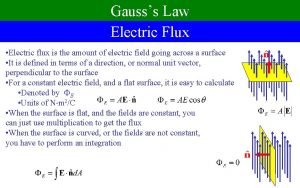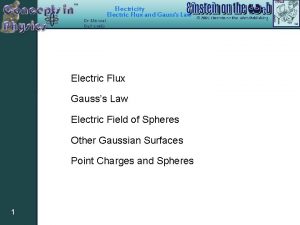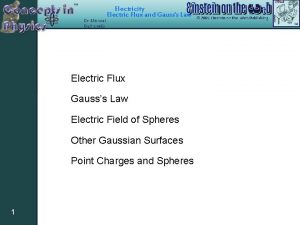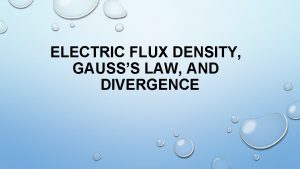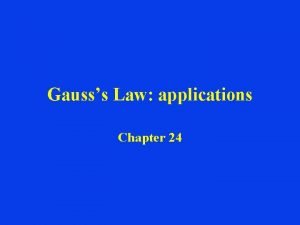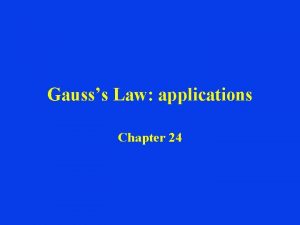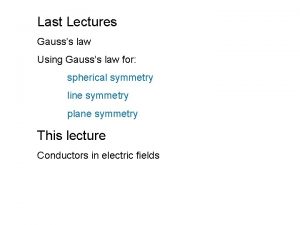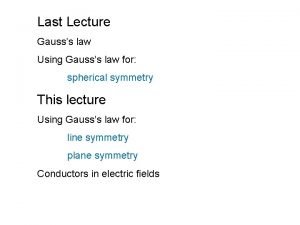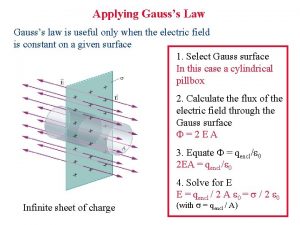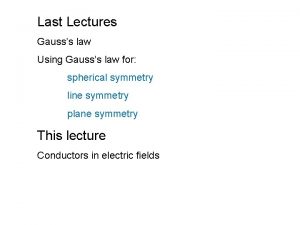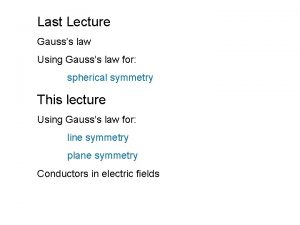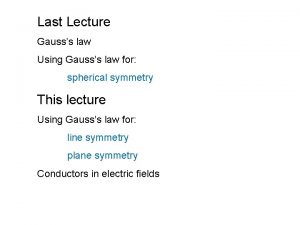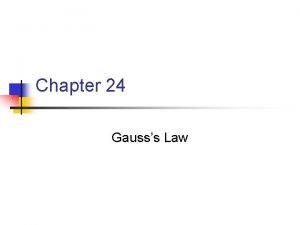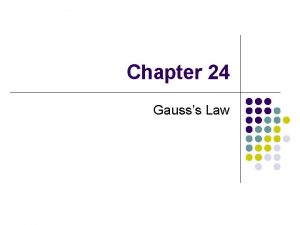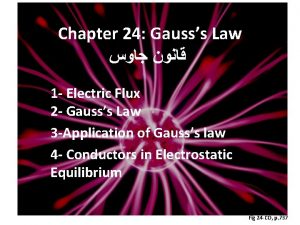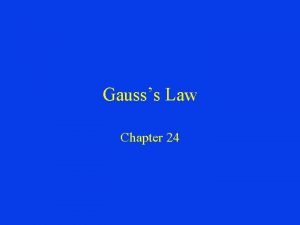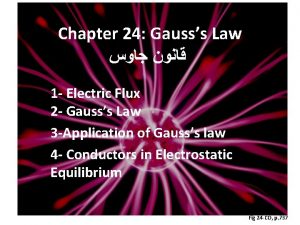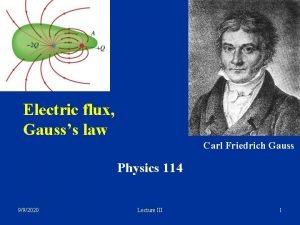Chapter 24 Summary Gausss Law Electric Flux Electric

























- Slides: 25

Chapter 24 - Summary Gauss’s Law

Electric Flux Electric flux is the product of the magnitude of the electric field and the surface area, A, perpendicular to the field. ΦE = EA Units: N · m 2 / C Section 24. 1

Electric Flux, General Area The electric flux is proportional to the number of electric field lines penetrating some surface. The field lines may make some angle θ with the perpendicular to the surface. Then ΦE = EA cos θ Section 24. 1

Electric Flux, Interpreting the Equation The flux is a maximum when the surface is perpendicular to the field. § θ = 0° The flux is zero when the surface is parallel to the field. § θ = 90° If the field varies over the surface, Φ = EA cos θ is valid for only a small element of the area. Section 24. 1

Electric Flux, General In the more general case, look at a small area element. In general, this becomes § The surface integral means the integral must be evaluated over the surface in question. In general, the value of the flux will depend both on the field pattern and on the surface. Section 24. 1

Electric Flux, Closed Surface Assume a closed surface The vectors directions. point in different § At each point, they are perpendicular to the surface. § By convention, they point outward. Section 24. 1

Flux Through Closed Surface, cont. At (1), the field lines are crossing the surface from the inside to the outside; θ < 90 o, Φ is positive. At (2), the field lines graze surface; θ = 90 o, Φ = 0 At (3), the field lines are crossing the surface from the outside to the inside; 180 o > θ > 90 o, Φ is negative. Section 24. 1

Flux Through Closed Surface, final The net flux through the surface is proportional to the net number of lines leaving the surface. § This net number of lines is the number of lines leaving the surface minus the number entering the surface. If En is the component of the field perpendicular to the surface, then § The integral is over a closed surface. Section 24. 1

Flux Through a Cube, Example The field lines pass through two surfaces perpendicularly and are parallel to the other four surfaces. For face 1, ΦE = -El 2 For face 2, ΦE = El 2 For the other sides, ΦE = 0 Therefore, ΦEtotal = 0 Section 24. 1

Karl Friedrich Gauss 1777 – 1855 Made contributions in § Electromagnetism § Number theory § Statistics § Non-Euclidean geometry § Cometary orbital mechanics § A founder of the German Magnetic Union § Studies the Earth’s magnetic field Section 24. 2

Gauss’s Law, Introduction Gauss’s law is an expression of the general relationship between the net electric flux through a closed surface and the charge enclosed by the surface. § The closed surface is often called a gaussian surface. Gauss’s law is of fundamental importance in the study of electric fields. Section 24. 2

Gauss’s Law – General A positive point charge, q, is located at the center of a sphere of radius r. The magnitude of the electric field everywhere on the surface of the sphere is E = keq / r 2 Section 24. 2

Gauss’s Law – General, cont. The field lines are directed radially outward and are perpendicular to the surface at every point. This will be the net flux through the gaussian surface, the sphere of radius r. We know E = keq/r 2 and Asphere = 4πr 2, ΦE = 4πkeq = q/εo Section 24. 2

Gaussian Surface, Example Closed surfaces of various shapes can surround the charge. § Only S 1 is spherical Verifies the net flux through any closed surface surrounding a point charge q is given by q/eo and is independent of the shape of the surface. Section 24. 2

Gaussian Surface, Example 2 The charge is outside the closed surface with an arbitrary shape. Any field line entering the surface leaves at another point. Verifies the electric flux through a closed surface that surrounds no charge is zero. Section 24. 2

Gauss’s Law – Final The mathematical form of Gauss’s law states § qin is the net charge inside the surface. represents the electric field at any point on the surface. § is the total electric field and may have contributions from charges both inside and outside of the surface. Although Gauss’s law can, in theory, be solved to find for any charge configuration, in practice it is limited to symmetric situations. Section 24. 2

Properties of a Conductor in Electrostatic Equilibrium When there is no net motion of charge within a conductor, the conductor is said to be in electrostatic equilibrium. The electric field is zero everywhere inside the conductor. § Whether the conductor is solid or hollow If the conductor is isolated and carries a charge, the charge resides on its surface. The electric field at a point just outside a charged conductor is perpendicular to the surface and has a magnitude of σ/εo. § s is the surface charge density at that point. On an irregularly shaped conductor, the surface charge density is greatest at locations where the radius of curvature is the smallest. Section 24. 4

Property 1: Fieldinside = 0 Consider a conducting slab in an external field. If the field inside the conductor were not zero, free electrons in the conductor would experience an electrical force. These electrons would accelerate. These electrons would not be in equilibrium. Therefore, there cannot be a field inside the conductor. Section 24. 4

Property 2: Charge Resides on the Surface Choose a gaussian surface inside but close to the actual surface. The electric field inside is zero (property 1). There is no net flux through the gaussian surface. Because the gaussian surface can be as close to the actual surface as desired, there can be no charge inside the surface. Section 24. 4

Property 2: Charge Resides on the Surface, cont. Since no net charge can be inside the surface, any net charge must reside on the surface. Gauss’s law does not indicate the distribution of these charges, only that it must be on the surface of the conductor. Section 24. 4

Property 3: Field’s Magnitude and Direction Choose a cylinder as the gaussian surface. The field must be perpendicular to the surface. § If there were a parallel component to , charges would experience a force and accelerate along the surface and it would not be in equilibrium. Section 24. 4

Sphere and Shell Example Conceptualize § A charged sphere is surrounded by a shell § Note charges Categorize § System has spherical symmetry § Gauss’ Law can be applied Section 24. 4

Sphere and Shell Example, cont. Analyze § Construct a Gaussian sphere between the surface of the solid sphere and the inner surface of the shell. § Region 2 § a<r<b § Charge inside the surface is +Q § The electric field lines must be directed radially outward and be constant in magnitude on the Gaussian surface. Section 24. 4

Sphere and Shell Example, 3 Analyze, cont. § The electric field for each area can be calculated. Section 24. 4

Sphere and Shell Example Finalize § Check the net charge. § Think about other possible combinations. § What if the sphere were conducting instead of insulating? Section 24. 4
 Conclusion of gauss law
Conclusion of gauss law Gausss law
Gausss law Magnetic retentivity
Magnetic retentivity Magnetic field density
Magnetic field density In the figure the net electric flux through the area a is
In the figure the net electric flux through the area a is Surface integral of electric field
Surface integral of electric field What is electric flux
What is electric flux Electric flux
Electric flux Electric flux
Electric flux Fluxea
Fluxea Electric flux density
Electric flux density Electric flux
Electric flux Electric flux definition
Electric flux definition What is electric flux
What is electric flux Electric flux density
Electric flux density Electric flux density
Electric flux density In the figure the net electric flux
In the figure the net electric flux Flux capacitor schematic
Flux capacitor schematic Electric flux capacitor
Electric flux capacitor Chapter 21 electric charge and electric field
Chapter 21 electric charge and electric field Chapter 21 electric charge and electric field
Chapter 21 electric charge and electric field Coloumb units
Coloumb units Dc o/d per item charge
Dc o/d per item charge Newton's first law and second law and third law
Newton's first law and second law and third law Newton's first law and second law and third law
Newton's first law and second law and third law Boyles law
Boyles law
